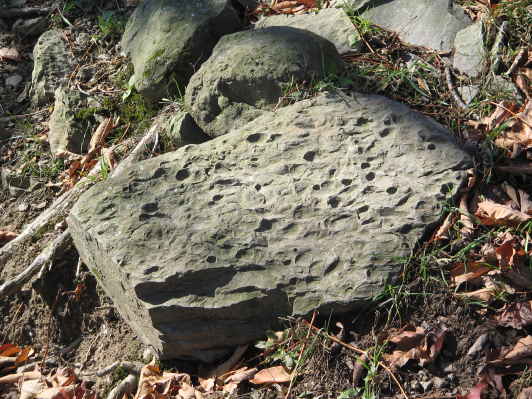![]() Observation: The First Step in the Scientific Method
Observation: The First Step in the Scientific Method
To observe means to use your senses to examine something. Careful observers notice the details. When scientists observe things, they ask questions. They might wonder many different things. How did this get here? What is this? Why is this shaped this way? What happened here? Scientists then seek to answer their questions. These observations are the initial step in the scientific method.
Observations are also called data. There are two kinds of data.
- Qualitative data are descriptions that do not have numbers.
The icy water is clear and a dark blue is an example of qualitative data.
- Quantitative data are obtained by measuring and have numbers. Scientists use instruments (tools) to obtain numbers based data.
The temperature of the lake's water is 10 degrees Celsius. The pH is 6.1 is quantitative data.
It is important to be a careful observer. The smallest detail could be important to finding the answer to a question.
Grace and Ben are a bit winded when they finally reached the top of the mountain that is on their grandparents' farm. The farm is in Richmond Township, Tioga County, in north Central Pennsylvania.
They climbed the mountain planning to discover just how far they could see across the valley. They thought perhaps they would see the buildings of the nearby town of Wellsboro.
The view from the top of the hill was exciting, but what really surprised them was what they found at their feet.
Near the crest of the mountain, they saw an enormous rock.
The closer they looked at the rock, the more excited they became.
They are amazed by what they saw covering the surface of the huge stone.
Click here for a closer view of the rock. (Notice that the cursor changes to a magnifying glass with a + plus sign in the middle. Use it to click again on the image for a BIG view. Use the Back Button of your browser to return to this web page.)

This is a much closer view of the upper, left area of the rock.
Click on the picture to see it a bit closer.
1. Write your observations.
Imagine - If you were standing there, looking at this rock:
What tools (instruments) would help you to be a better observer?
What tools (instruments) would you use to make measurements?
2. Fire up your imagination or curiosity. Write at least two questions about what you have observed.
3. TAI (Think About It) Which fields of science would be interested in studying this rock?
4. Form a hypothesis. (What is a hypothesis?)
"Discovery consists in seeing what everyone else has seen and thinking what no one else has thought."
Albert Szent-Györgi (1893-1986) Nobel Prize winning U. S. biochemist.
Journey further:
About Units of Measurement - IB Biology | Rock Classification
Steps of the Scientific Method - Science Buddies | Learn about the Scientific Method
Explore Fossil Facts and Finds | Common fossils of Pennsylvania | Rocks for Kids | Rockhounds
The Geological Story of Pennsylvania | Make copies of nature's treasures by using techniques called molding and casting
Animal Phyla - 13. Phylum Brachiopoda (Brachiopods) | Observation Skills Builders index
Geology of Pennsylvania | Finding Fossils | Rocks & Minerals Internet activity | Earth's Layers Internet Hunt
Water & Watersheds Study Unit | Bluebirds Project | Wetland EcoStudy Unit | Fields, Meadows and Fencerows Ecostudy Unit
![]()
All trademarks, copyright and logos belong to their respective owners.
Internet Hunts / Nature / Water / Computers / Famous Pennsylvanians / Civics & History / Puzzles & Projects / Site map / Home
Posted
by Cynthia J. O'Hora 10/2008, released for noncommercial use by nonprofit organizations
Aligned
with Pennsylvania Academic Standards | Assessment and Rubrics
Pennsylvania Academic Standards - The Nature of Science
Processes, Procedures and Tools of Scientific Investigations
• Apply knowledge of scientific investigation or technological design in different contexts to make inferences to solve problems.
• Use evidence, observations, or a variety of scales (e.g., time, mass, distance, volume, temperature) to describe relationships.
![]() Save a tree - use a Digital Answer Format - Highlight the text. Copy it. Paste it in a word processing document. Save the document in your folder. Answer on the word processing document in an easily read, contrasting color or font. (Not yellow ) Avoid fancy fonts like Symbols, Techno,
Save a tree - use a Digital Answer Format - Highlight the text. Copy it. Paste it in a word processing document. Save the document in your folder. Answer on the word processing document in an easily read, contrasting color or font. (Not yellow ) Avoid fancy fonts like Symbols, Techno, ![]() fonts). Save frequently as you work. I have never liked losing my work. You will not like it either. Be sure to enter your name & the date at the top of the document in a header. Submit your work via an email attachment or class dropbox. Bad things happen: Save a copy of the response document for your records.
fonts). Save frequently as you work. I have never liked losing my work. You will not like it either. Be sure to enter your name & the date at the top of the document in a header. Submit your work via an email attachment or class dropbox. Bad things happen: Save a copy of the response document for your records.
Proof your responses. It is funny how speling errors and typeos sneak in to the bets work. ![]() Make your own printer paper answer sheet
Make your own printer paper answer sheet

